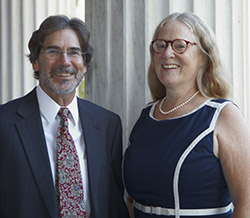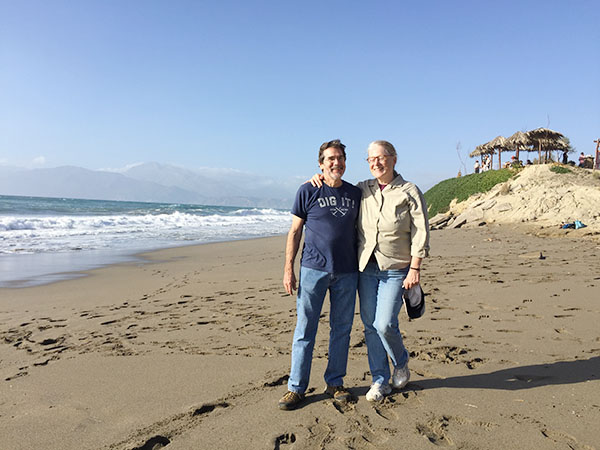Jim Wright and Mary Dabney Reflect on Their Departure

Jim and Mary during their first term at the School
School Director Jim Wright and Mary Dabney leave the School June 30th at the conclusion of Wright’s five-year term of steady and visionary leadership. Wright returns to Bryn Mawr College as Professor emeritus in the Department of Classical and Near Eastern Archaeology, where he will continue research in his specialty of the archaeology of the prehistoric Aegean. Here, he and Dabney share their most memorable experiences in Greece, reflect on the vital contributions they were able to make, and communicate their hopes for the future of the School.
What will you miss most about the School? About living in Greece?
Wright: I will miss the active engagement with the community: greeting staff in the morning and working with them through the day, having luncheon conversations with our members, solving problems by bringing people together to work them through, taking a moment in the afternoon in the calming solitude of the garden. I will miss the tasty dinners in one of the most elegant dining rooms in Greece; the uniquely social culture of Athens; walks Mary and I regularly took along Hymettus; day trips into the mountains of western Attica, or to Porto Germeno, or simply along the seashore at Faliron and Glyfada; and dinners out with friends. We’ll be back regularly for long sojourns.
Dabney: Mostly I will miss getting together with our friends who live here in Greece. I’ll also miss visiting new places in Greece and Europe. Going on School trips was special because we saw places that are difficult to find or not open to the public. The School trip to Ethiopia was especially memorable.

Jim and Mary at Kommos excavations on Crete
You have both been working in Greece your entire careers. What new things have you learned about the land and its people during these last five years?
Wright: Greece is about deep human history and that is a history of resilience. Living in Pitsidia when I was digging at Kommos and then in Ancient Nemea, I learned how close the villagers were to the soil—but, living in Greece during this prolonged economic and social crisis, I have realized how deeply embedded is this spirit of making do with very little. It’s been hard to see the devastation to people’s lives, to families, to businesses and institutions. At the same time the crisis has sparked me to think deeply about archaeology’s responsibility to study all periods and to seek understanding of the long-term lessons of such a perspective.
Dabney: The resilience of the Greek people during the financial hardships these last five years has helped me understand why Greeks have made so many contributions to world history.
Did you two develop any traditions for yourselves during your time here? Did any new School traditions develop during your tenure?
Wright: We have a group of friends with whom we go on weekend picnics and celebrate Tsiknopempti (the Thursday before Lent, when Greeks feast on grilled or smoked meat). For Thanksgiving, we started the tradition that the School would provide the turkeys and the members and staff would bring side dishes and desserts. By inviting everyone to participate, more people came and brought their children.
Which accomplishments as Director are you most proud of?
Wright: I hope I have strengthened our community by emphasizing the interconnectedness of the study of all pasts and the importance of learning about contemporary Greece. I’m grateful to Malcolm Wiener for the new laboratory and to Takis Karkanas for realizing its potential. I think our library team has really come together over the plans for the integration of the libraries, which was the impetus for the Gennadius West Wing project. I wish I had found the money to turn the upper parking lot into a welcoming garden, but I’m proud that we will have re-landscaped two of our gardens.
What have been the challenges of directing the School during this period of economic crisis in Greece?
Wright: It has been very stressful for Demetra Bakodima, Dina Zissopoulou, and Mr. Panos to deal with the constantly changing tax and employment laws, the bureaucracy of the ESPA projects, the bank controls, and the two building projects. It’s always a challenge to manage an operation that straddles two continents and has many constituents. I think the School is facing major structural changes as it adjusts to the administrative and governance challenges facing non-profit educational institutions, and I hope I have helped increase awareness of the need for the director to play a lead role.
The physical character of the School has changed during your tenure—the new Wiener Lab, the West Wing extension of the Gennadius, new gardens, and now permission to build a new Apotheke at Corinth—what has it been like to lead these initiatives and how will they impact the future of the School?
Wright: Bricks and mortar must be about improving programs. The old lab space prevented us from doing the kind of science we aspire to. Until we renovated the Gennadius West Wing, we were unable to fulfill the goals of the Mellon-funded studies to integrate the libraries and the NEH Challenge Grant to integrate Archives with Special Collections. We needed a larger and separate space to exhibit our treasures and realize our mission to share with the public. Buildings have to fit and enhance the character of the institution through their design and placement. Our architects, engineers, and contractors worked hard to achieve tasteful and functional results: sitting in the new gardens is the best way to appreciate the aesthetics and the integration of these new buildings.
The academic program has also seen some changes, namely the addition of a Summer Seminar and restructuring the School entrance exam. How is the School preserving its renowned academic tradition while responding to emerging trends in the field and the needs of its constituents?
Wright: The academic program is remarkably sturdy, yet it is also a product of steady evolution. These are minor adjustments made by the Managing Committee. The Mellon professor and I contribute our on-the-ground perspective of what seems right. One of our major responsibilities is to adjust to new opportunities and realities in Greece and communicate to the wider community why changes, mostly incremental, are necessary to keep pace.
How has the School raised its profile in the Athens and international communities?
Wright: As I write, a program called Open House Athens has been bringing hundreds of locals to visit the new laboratory. Natalia has just posted a new entry on her “Archivist’s Notebook” blog. Moira is steadily increasing our profile on Facebook, Twitter, Instagram, and through her weekly e-letter. Ioulia and Katie continue to work with K-12 schools in the Corinthia and through the web, and Skype to schools in the U.S. thanks to the Steinmetz grant. George has launched “Conversations” throughout the U.S. Takis is creating all kinds of research networks within Greece and Europe and across the U.S. for the laboratory. documenta 14 Athens-Kassel has three artists exhibiting in the Gennadeion from April through July. The Curtis Institute of Music “On Tour” program will come for a third series of free concerts in Cotsen Hall. For three years, we have been an academic partner with the New York Times and Kathimerini for the UN Day of Democracy celebrations every September 15th. The Consortium of European Research Libraries just met and participated in an international conference co-sponsored by the Gennadeion and the Laskaridis Foundation. We held two international academic conferences in Cotsen Hall this year.
Mary, you dedicated considerable time to advancing the publication project for the Nemea Valley Archaeological Project and presented some of your scholarship at lectures. You were also involved with the Mediterranean Garden Society, among other organizations. Most recently, you led a group of refugees on a tour of the Argolid. What inspired you to focus on these endeavors and what did you find to be fulfilling about them?
Dabney: As archaeologists, we have a responsibility to publish the results of our excavations. As a student, I was often sad to learn that many excavators in Greece never finished publishing their work during their lifetime. Being a Senior Associate Member at the School made it possible to focus on coordinating the publications of our Tsoungiza and Ayia Sotira excavations in the Nemea Valley, both of which were multidisciplinary team efforts. I even organized a workshop at the AIA Annual Meetings on Managing Multidisciplinary Field Projects. Joining the Mediterranean Garden Society (MGS) was really about learning how to select and propagate plants for my garden on the ASCSA Director’s House roof, which is extremely windy and dry. MGS organizes great educational trips to visit gardens.
What are your immediate and future plans?
Wright: A month at Lake Dunmore in Vermont before taking up the Visiting Professorship of the Australian Archaeological Institute in Athens lecture program in Australia from mid-August to late September, then a tour through Indonesia before returning to Gladwyne, PA in early October to put our house in order and figure out where to put all my books. I have two books and many articles I am eager to write, research in Greece on ground stone tools, and I will prepare the keynote lecture for the Aegaeum Conference in Venice next April.
Dabney: And we are already planning to come back to Greece next April—we can’t stay away.
What advice have you given incoming Director Jenifer Neils?
Wright: Be grateful for the opportunity to lead this wonderful institution; don’t sweat the small stuff; trust the staff—they know better, but don’t hesitate to lead when you sense the direction they want to go. And use Skype a lot!